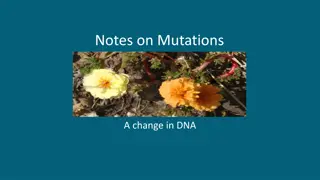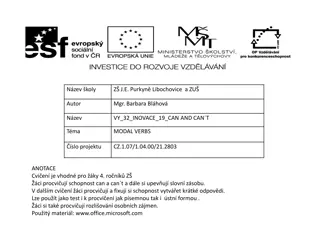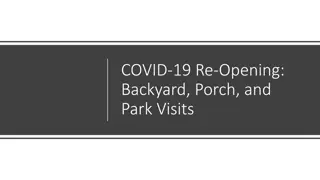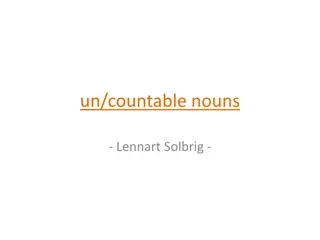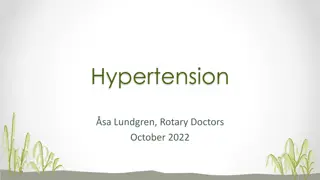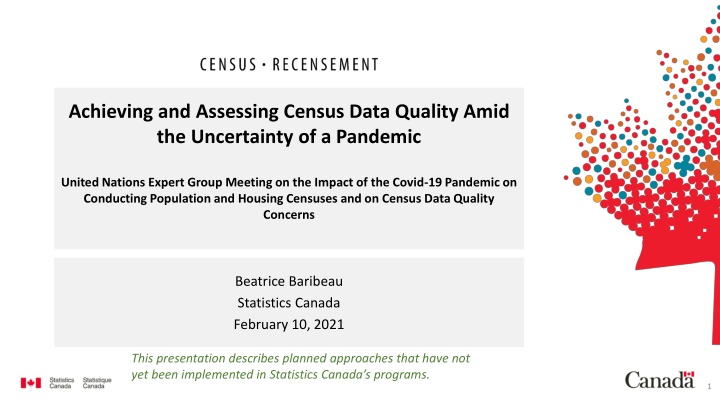
Achieving and Assessing Census Data Quality Amid COVID-19 Uncertainty
Explore the strategies and challenges of maintaining data quality during the pandemic with Statistics Canada's planned approaches for the Canadian Census. Learn about mitigation plans, assessment methodologies, and the innovative wave methodology designed to boost response rates.
Download Presentation

Please find below an Image/Link to download the presentation.
The content on the website is provided AS IS for your information and personal use only. It may not be sold, licensed, or shared on other websites without obtaining consent from the author. If you encounter any issues during the download, it is possible that the publisher has removed the file from their server.
You are allowed to download the files provided on this website for personal or commercial use, subject to the condition that they are used lawfully. All files are the property of their respective owners.
The content on the website is provided AS IS for your information and personal use only. It may not be sold, licensed, or shared on other websites without obtaining consent from the author.
E N D
Presentation Transcript
Achieving and Assessing Census Data Quality Amid the Uncertainty of a Pandemic United Nations Expert Group Meeting on the Impact of the Covid-19 Pandemic on Conducting Population and Housing Censuses and on Census Data Quality Concerns Beatrice Baribeau Statistics Canada February 10, 2021 This presentation describes planned approaches that have not yet been implemented in Statistics Canada s programs. 1
Overview The Canadian Census of Population context and challenges Mitigation & Contingency planning due to COVID Plan A: Adapting collection strategies Plan B: Plan A + Ongoing research for contingency planning Assessment of Data Quality Certification New quality indicators 2
The Canadian Census of Population Context & Challenges Collection Methodologies Mail-out (86% of dwellings) Urban areas where invitation/reminder letters can be delivered directly to the dwelling Mail-out with drop-off (>6% of dwellings) Mix of mail delivery where possible (like mail-out) and enumerators dropping Census materials at remaining dwellings List/leave (6% of dwellings) Rural areas where enumerators are sent to list all dwellings and deliver Census material Canvasser/Reserve (1% of dwellings) Remote areas where Census questionnaires are typically completed via in-person interviews Collecting in the brown and tan regions (where materials cannot be mailed) requires enumerators *Risk* 3
The wave methodology is designed to achieve high response rates and elicit self-response through varied, targeted prompts 2021 Census Wave Methodology NRFU Final Wave July 19-20 May 11 CENSUS DAY Wave 1 MO Invitation Letter May 3 Wave 2 Reminder Letter May 12-20 Wave 3 Final Notice May 20-31 Text message reminder or Automated call May 31 NRFU Non-Response Follow-up June 2 July 30 Mail-out Non-Response Non-Response Non-Response Non-Response 90% Paper Questionnaire Request System/Process Available to respondents from May 3 June 30 (automated system) Wave 2 Reminder/ Thank you card May 12-14 NRFU Wave 1 DD Invitation Letter May 3 -10 List/Leave / List-Leave Non-Response Non-Response Follow-up May 21 July 16 Drop-Off 9% NRFU Drop-Off Non-Response Non-Response Follow-up June 2 July 30 Wave 1 MO Invitation Letter May 3 Canvasser / NRFU Reserve Non-Response Follow-up May 14- July 16 Non-Response 1% Wave 1 DD Invitation Letter May 3 -10 MO: Mail-out DD: Door-dropper Material delivered by CPC
Mitigation & Contingency planning due to COVID COVID may interfere with collection. To ensure quality we need to be ready with a Plan B Plan A: Optimal collection strategies to achieve high response through self response rates and minimal contact in nonresponse follow-up Plan B: Plan A + Statistical contingency planning based on administrative data to treat nonresponse 5
Plan A: Mitigating Risks to Response Rate by Optimizing Collection Base Collection strategy: NEW for Non-response follow-up: Promote self-response wave methodology + SMS and email reminders Concentrate nonresponse follow-up (NRFU) where needed most Identify unoccupied/cancelled dwellings for more efficient NRFU Tolerance strategy identifies where targets are met to re-allocate resources Dynamic model to assess progress A final wave (reminder letter) was added Additional telephone resources allocated When face-to-face visits are required: Local hiring is a priority Enumerators will be provided with PPE and will practice physical distancing Soft approach will be used during the first contact to encourage self-response 6
Plan B: Contingency planning with admin data Apply usual donor imputation for the short form of the Census Response Rates High New imputation step for Imputing occupied dwellings and imputing age & sex Lower Invoke Statistical Contingency Plan Need to determine a trigger for plan Plan B: Need criteria to determine eligibility Use admin data 7
Plan B: Contingency planning with admin data Eligibility For Admin Data Imputation 1 2 3 Identified necessity (quality risks) & potential for improvement from admin data A lot of research has been conducted. Key Findings presented in next slides Available admin data deemed of reliable quality Admin data imputation fits within other established imputation procedures 8
Plan B: Contingency planning with admin data Probabilities produced from the models serve to create the modelled admin households and indicate their quality. Admin Data Quality Indicators Household Model indicators: The person-place model: assess the probability that the admin address reflects the true address for an individual. Using this model, choose address with highest probability for each individual and form household The household composition model: assess the probability that the admin derived household members reflect the true household composition at a given address Probability that DOB and sex attributes are correct Probability that the dwelling is occupied Some Concepts 9
Plan B: Contingency planning with admin data Household Composition Model for Occupied Dwellings Match category* for a given dwelling h: % of Finding 1: Across all dwellings, the results are relatively good with close to 60% of dwellings being a perfect match and 91.5% being at least a partial match to 2016 Census households. dwellings Perfect match: All persons match Partial Match: Not a perfect match but at least one person matches Non-match: no person matches 59.2% 32.3% 8.5% *Admin-based households assessed by comparing to 2016 Census data 10
Assessing Quality of the Household Model Plan B: Contingency planning with admin data Availability and Performance by 2016 mail-out and non-mail-out areas 2016 Mail- Out Admin Data Available 2016 Non- Mail-Out 87.9% 49.1% Finding 2: In non-mailout areas (where response rates are more at risk) admin data is less available and the quality is reduced. Predicted to be a Perfect Match 61.0% 32.5% Error Rate of Predicted Perfect Matches 19.5% 23.3% 11
Assessing Quality of the Household Model Plan B: Contingency planning with admin data Non-mailout area Error Rate* (percentage that are not a perfect match) for simulated nonresponse rates and by threshold Finding 3: Applying a threshold to the minimum probability required reduces the error rate ? ?.?? ? ?.?? ? ?.?? Simulated nonresponse rates All dwellings Higher thresholds results in lower error rates. 51% 46% 39% 38% ~10% 63% 59% 53% 55% ~5% ~2% 91% 90% 89% 87% *2016Non-mailout dwellings and short-form only Finding 4: The error rates for perfect matches of nonresponding households increase as nonresponse decreases. (Some imperfect matches will still be partial matches). 12
Plan B: Contingency planning with admin data Contingency Plans and other potential impacts Imputation using admin data will respect other established procedures for whole household imputation of nonresponding households To ensure proper number of households imputed as occupied, with correct distributions by size Coverage studies (which rely on admin data) will continue to produce unbiased estimates of net undercoverage even in the presence of admin data imputed households 13
Plan B: Contingency planning with admin data Next Steps Eligibility For Admin Data Imputation 1 2 3 Compare simulated results using admin data to those without using admin data Identified necessity (quality risks) & potential for improvement from admin data Available admin data deemed of reliable quality Operationalize an admin imputation process respecting other constraints Admin data imputation fits within other established imputation procedures 14
Assessment of Data Quality - Certification Returning Features New/Improved for 2021 Investigating data quality measures total non-response rates item non-response rate edit failure rates imputation rate change rate data comparison before and after imputation Coherence Past censuses other surveys administrative sources. Cross-tabulations Checked for consistency and accuracy Consult internal and external experts when needed (Improved in 2021) Outlier Identification and verification (New in 2021) Checks to ensure no systematic error has been introduced (New in 2021) Data visualization and maps (New in 2021) + 15
Assessment of Data Quality Reporting on Quality New quality indicators are being introduced for the 2021 Census. For the short-form and long-form Census: Moving from Global non-response to using Total Non-response and having item/question quality indicators the imputation rate (imputation of a component or entire household the non-response rate (when no item response is obtained) if nonresponse is higher Key quality metrics with increased value In addition, for the long-form Census (based on a sample): Using confidence intervals in Census tables Using an extension of the Wilson confidence interval adapted for weighted totals 16
Conclusion Collection strategies have been adapted to the current context A Plan B to impute (age and sex) using admin data is being strategically designed. This Plan B will be implemented only if: Census quality is at risk Simulations have shown admin data will improve quality Reliable admin data is available for nonresponding households The household composition in available admin data households used for imputation corresponds to required imputations by distribution and size Coverage Studies are designed to be unbiased with invocation of a contingency plan Thorough certification will be conducted Resulting quality will be reported transparently though new quality indicators 17
Thank you! / Merci! Questions? beatrice.baribeau@canada.ca 18









